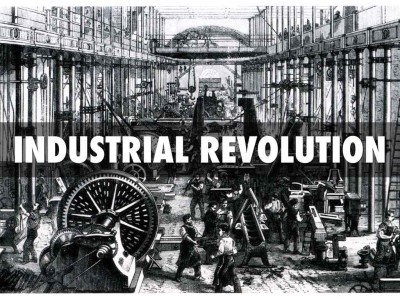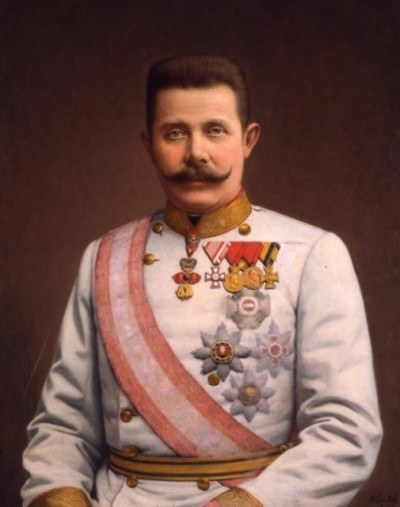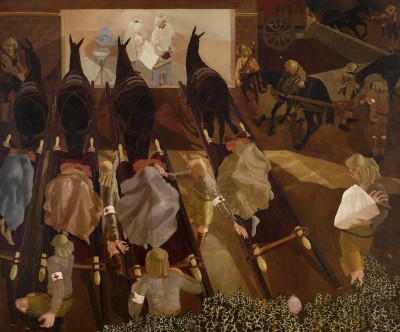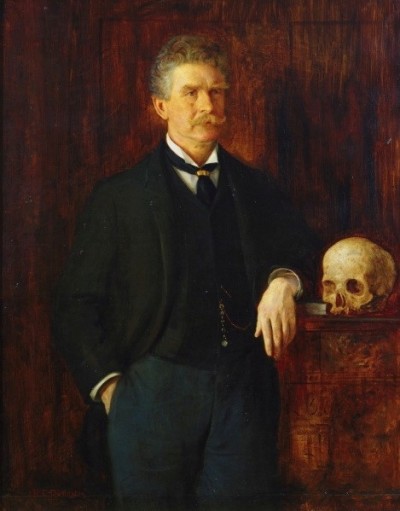Course description
The Industrial Revolution & the Fathers of Capitalism
Most revolutions change national governments; a few change the ways people think about their political and social rights. A small minority might spread across a country’s borders and shape new directions for human progress. These come and go as fashions and beliefs change. They rarely last as long as a century. However, the Industrial Revolution transformed the entire world forever. It affected life expectancy, the communities we live in, where we work, the need for education and the ways we see our futures. It dictated the growth of empire, the rise of cities, and the health of the planet we live on.

512px-Villaggio._Village._Dorf._Village._Dorp_(titel_op_object),_RP-P-OB-200.995.jpg (512×408)In Britain in 1750, which marked the start of the Industrial Revolution, the population was not much over 5 million and life expectancy was about 33 years of age: many, many people died in the first five years of life and few made it past 40, unless they were wealthy. The vast majority lived in villages or small towns and worked on the land. There was a local lord or gentleman – a chief citizen – who kept law and order, rented out property and fields and, in the best cases, cared for the sick. Communities were small and looked after their own needy. People were born, married and died. Not many travelled more than a few miles from their villages. Just about everybody expected their life to remain as it was until they breathed their last breath.
 512px-Arkwright-water-frame.jpg (512×824)Even in major cities like London, which had a population of about half a million in 1700, most work revolved around produce from the land, especially wool. Businessmen had an army of workers who lived and worked in their homes in villages across the country and earned wages based on how much they produced. Even fairly small children had jobs they were expected to do at home. This type of employment was so widespread that it had a name: cottage industry. Parents knew their children and grandchildren would live very similar – even identical – lives to their own.
Half a century later, all that had changed. The invention of textile machines, like James Hargreaves’ Spinning Jenny in 1764 and Richard Arkwright’s water frame five years later, meant that material could be spun perhaps 200 times faster than an individual could do it by hand. This, in turn, led to great pressure to invent machines that could weave all this spun material into cloth.
Clearly, it was impossible for most families to buy a spinning machine, even if they lived next to a stream with running water that could power it and, so, cottage industry began to die out. The invention of much larger steam-powered machines necessitated the building of factories where they could be housed and the construction of better roads and canals to transport goods to the major cities and ports. Obviously, as there was afterwards little employment in village homes, men were forced to move closer to the factories where they could find work. So, towns and, later, cities sprang up, clustered around those factories.
Steam-powered engines were fuelled by coal which was found in many places and in great amounts in northern and eastern England. It was this resource that pushed the Industrial Revolution ahead – along with the invention of pumps to extract the water down the pits and so allow for mining deep below the ground. Of course, towns also grew up around the mines.
There was a sense among factory owners that change was not only necessary but desirable.
The new towns grew very suddenly and very fast to accommodate the tidal wave of villagers arriving to find jobs, in fact they grew so suddenly and so fast that there was no basic infrastructure to support them. Disposal of food, human and animal waste had not been considered and overcrowding was the norm, as new recruits had very little money to waste on spacious rooms. It was to be expected, therefore, that diseases like typhoid, dysentery, cholera and more were frequent visitors to these new habitations.
512px-Arkwright-water-frame.jpg (512×824)Even in major cities like London, which had a population of about half a million in 1700, most work revolved around produce from the land, especially wool. Businessmen had an army of workers who lived and worked in their homes in villages across the country and earned wages based on how much they produced. Even fairly small children had jobs they were expected to do at home. This type of employment was so widespread that it had a name: cottage industry. Parents knew their children and grandchildren would live very similar – even identical – lives to their own.
Half a century later, all that had changed. The invention of textile machines, like James Hargreaves’ Spinning Jenny in 1764 and Richard Arkwright’s water frame five years later, meant that material could be spun perhaps 200 times faster than an individual could do it by hand. This, in turn, led to great pressure to invent machines that could weave all this spun material into cloth.
Clearly, it was impossible for most families to buy a spinning machine, even if they lived next to a stream with running water that could power it and, so, cottage industry began to die out. The invention of much larger steam-powered machines necessitated the building of factories where they could be housed and the construction of better roads and canals to transport goods to the major cities and ports. Obviously, as there was afterwards little employment in village homes, men were forced to move closer to the factories where they could find work. So, towns and, later, cities sprang up, clustered around those factories.
Steam-powered engines were fuelled by coal which was found in many places and in great amounts in northern and eastern England. It was this resource that pushed the Industrial Revolution ahead – along with the invention of pumps to extract the water down the pits and so allow for mining deep below the ground. Of course, towns also grew up around the mines.
There was a sense among factory owners that change was not only necessary but desirable.
The new towns grew very suddenly and very fast to accommodate the tidal wave of villagers arriving to find jobs, in fact they grew so suddenly and so fast that there was no basic infrastructure to support them. Disposal of food, human and animal waste had not been considered and overcrowding was the norm, as new recruits had very little money to waste on spacious rooms. It was to be expected, therefore, that diseases like typhoid, dysentery, cholera and more were frequent visitors to these new habitations.
 512px-Child_labour_cartoon_Hine_no_2870..jpg (512×613)Naturally, as machines could produce goods hundreds of times faster than people working only with their hands, fewer workers were needed, especially because – to keep costs low – employers insisted on very long working days. As an example, it was only with the Factories Act of 1833 that Parliament reduced the working day to eight hours for children up to 13 and to twelve hours for those from 14 to 18. As such, there were many disappointed would-be labourers wandering the streets with no way of feeding themselves or sending money home to their villages. Strong drink was often cheaper than food and killed the appetite. This, in turn, led to fighting, prostitution, rape, in addition to robbery, burglary and other kinds of theft that the unemployed were forced into in order to eat. Crime, in other words, was everywhere.
But, back home in the villages, many families felt abandoned by the young men who had travelled to the cities to support their families when the system of cottage industry broke down. Mothers could not pay the rent and the age-old tradition of caring for the elderly and needy could not continue. There was simply no money coming in. Landlords threw families out of the homes that they had, perhaps, lived in for generations. They were then homeless and had to make their way to the cities to find work.
The Industrial Revolution would eventually greatly increase life expectancy, insist on compulsory education for the young and improve the quality of life in other ways as well. But the government had to introduce a number of radical new measures first. Tens of thousands of people were wandering the countryside because their homes had been taken from them. Many of them died of starvation; others stole fruit from orchards and killed farm animals to fill their stomachs. Others – called Luddites – smashed the new machines in a desperate and futile attempt to return to the old agrarian economy. There was no police force to monitor, prevent or prosecute these crimes.
512px-Child_labour_cartoon_Hine_no_2870..jpg (512×613)Naturally, as machines could produce goods hundreds of times faster than people working only with their hands, fewer workers were needed, especially because – to keep costs low – employers insisted on very long working days. As an example, it was only with the Factories Act of 1833 that Parliament reduced the working day to eight hours for children up to 13 and to twelve hours for those from 14 to 18. As such, there were many disappointed would-be labourers wandering the streets with no way of feeding themselves or sending money home to their villages. Strong drink was often cheaper than food and killed the appetite. This, in turn, led to fighting, prostitution, rape, in addition to robbery, burglary and other kinds of theft that the unemployed were forced into in order to eat. Crime, in other words, was everywhere.
But, back home in the villages, many families felt abandoned by the young men who had travelled to the cities to support their families when the system of cottage industry broke down. Mothers could not pay the rent and the age-old tradition of caring for the elderly and needy could not continue. There was simply no money coming in. Landlords threw families out of the homes that they had, perhaps, lived in for generations. They were then homeless and had to make their way to the cities to find work.
The Industrial Revolution would eventually greatly increase life expectancy, insist on compulsory education for the young and improve the quality of life in other ways as well. But the government had to introduce a number of radical new measures first. Tens of thousands of people were wandering the countryside because their homes had been taken from them. Many of them died of starvation; others stole fruit from orchards and killed farm animals to fill their stomachs. Others – called Luddites – smashed the new machines in a desperate and futile attempt to return to the old agrarian economy. There was no police force to monitor, prevent or prosecute these crimes.
 512px-AdamSmith.jpg (512×764)But these dramatic changes that often meant – at least initially – such misery and poverty for villagers had a champion. Adam Smith, the founder of modern economics, in his 1776 volume, ‘The Wealth of Nations’, attempted to apply the same methods of reasoning and scientific enquiry to the movement and accumulation of money as others at the time were applying to the study of geology and chemistry. Smith was a Scotsman – and Scotland had more and better universities than England – and a friend of other gifted fellow countrymen of his and, so, knew of the work they were doing in these areas.
At a time when wealth was dependent on land and ‘gentlemen’ were either in the Army or simply went hunting or took up other hobbies, commerce was rather a dirty word. Some linked it to effeminacy because it drew attention away from the military careers that real men should follow. Others believed (for decades to come) that ‘gentlemen’ should not be concerned with money! Smith was of a different opinion. He argued that the self-interest of those who had capital and invested it in building factories and installing machines was, in fact, good for society as a whole. In other words, greed is good because self-interest promotes employment of others and this benefits the larger community and, indeed, nation. In his own words,
“It is not from the benevolence of the butcher or the baker that we expect our dinner, but from their regard to their own interest. We address ourselves, not to their humanity but to their self-love, and never talk to them of our own needs but of their advantages.”
512px-AdamSmith.jpg (512×764)But these dramatic changes that often meant – at least initially – such misery and poverty for villagers had a champion. Adam Smith, the founder of modern economics, in his 1776 volume, ‘The Wealth of Nations’, attempted to apply the same methods of reasoning and scientific enquiry to the movement and accumulation of money as others at the time were applying to the study of geology and chemistry. Smith was a Scotsman – and Scotland had more and better universities than England – and a friend of other gifted fellow countrymen of his and, so, knew of the work they were doing in these areas.
At a time when wealth was dependent on land and ‘gentlemen’ were either in the Army or simply went hunting or took up other hobbies, commerce was rather a dirty word. Some linked it to effeminacy because it drew attention away from the military careers that real men should follow. Others believed (for decades to come) that ‘gentlemen’ should not be concerned with money! Smith was of a different opinion. He argued that the self-interest of those who had capital and invested it in building factories and installing machines was, in fact, good for society as a whole. In other words, greed is good because self-interest promotes employment of others and this benefits the larger community and, indeed, nation. In his own words,
“It is not from the benevolence of the butcher or the baker that we expect our dinner, but from their regard to their own interest. We address ourselves, not to their humanity but to their self-love, and never talk to them of our own needs but of their advantages.”
 512px-thumbnail.jpg (511×315)Smith also believed that division of labour was essential for the maximization of profit. A single worker might take a morning to make a chair, for instance, but if the task was divided into its parts, it could be done much more quickly. Furthermore, greater separation of tasks meant that individual workers become more specialized and, so, expert at their specific jobs. This idea, in effect, revolutionized the world of work and dictated how factories needed to operate. These days, we call it ‘the assembly line’ and the arrangement can be found in factories the world over.
Adam Smith’s book, by the way, stated that government protectionism – or ‘mercantilism’ – where a country protects its own industry by taxing imports and sets prices for commodities interferes with the natural working of markets. He believed that prices would regulate themselves based on supply and demand, a law of economics. Simply, it means this: if something is in short supply, its price will go up (like mangoes at the start of the season each year or diamonds year in, year out). On the other hand, if there is a surplus of something, then its cost will decline (such as when there is a bumper crop of vegetables, they are much cheaper than usual to buy).
Adam Smith is often credited with setting out the principles of capitalism and has been described as a proponent of laissez-faire economics – or the idea that governments should not try to control markets but let them regulate themselves. All in all, Smith explained the moral philosophy and economic laws that justified business as a proper activity for the gentleman and as essential for any prosperous nation. It was no longer enough for the lord to farm his land and collect rent from his tenants.
512px-thumbnail.jpg (511×315)Smith also believed that division of labour was essential for the maximization of profit. A single worker might take a morning to make a chair, for instance, but if the task was divided into its parts, it could be done much more quickly. Furthermore, greater separation of tasks meant that individual workers become more specialized and, so, expert at their specific jobs. This idea, in effect, revolutionized the world of work and dictated how factories needed to operate. These days, we call it ‘the assembly line’ and the arrangement can be found in factories the world over.
Adam Smith’s book, by the way, stated that government protectionism – or ‘mercantilism’ – where a country protects its own industry by taxing imports and sets prices for commodities interferes with the natural working of markets. He believed that prices would regulate themselves based on supply and demand, a law of economics. Simply, it means this: if something is in short supply, its price will go up (like mangoes at the start of the season each year or diamonds year in, year out). On the other hand, if there is a surplus of something, then its cost will decline (such as when there is a bumper crop of vegetables, they are much cheaper than usual to buy).
Adam Smith is often credited with setting out the principles of capitalism and has been described as a proponent of laissez-faire economics – or the idea that governments should not try to control markets but let them regulate themselves. All in all, Smith explained the moral philosophy and economic laws that justified business as a proper activity for the gentleman and as essential for any prosperous nation. It was no longer enough for the lord to farm his land and collect rent from his tenants.
 512px-A_Short_History_of_the_World,_p0348.jpg (512×355)Another important social philosopher of the age, Jeremy Bentham, outlined his Theory of Utility in 1789, the year of the French Revolution. He argued utility was the probability that an action would increase collective happiness, rather than decrease it. The aim of the government was, therefore, the greatest happiness of the greatest number of citizens. Bentham attempted to measure ‘utility’ scientifically, not just to take feelings into account.
Although Bentham had no luck in persuading governments to implement his ideas, they were nevertheless very influential at a time when there was great concern about social control. Just across the thirty-five kilometers of sea that separate the south coast of England from France, a revolution was taking place, the king was held prisoner and the government was beheading (‘guillotining’) members of the aristocracy. Religion was abolished, the year was re-set at 0, and there was a ten-day week. There was universal suffrage: each and every man had the right to vote, regardless of whether he had any land or property or not. It was as if the French wanted to forget everything that had gone before, to wipe it out.
Of course, in Britain, there was panic. After all, there were thousands upon thousands of hungry and homeless people wandering the countryside. The cities were crowded with unemployed people with empty stomachs and no morals. The government had to act to prevent what had happened in France from happening at home.
512px-A_Short_History_of_the_World,_p0348.jpg (512×355)Another important social philosopher of the age, Jeremy Bentham, outlined his Theory of Utility in 1789, the year of the French Revolution. He argued utility was the probability that an action would increase collective happiness, rather than decrease it. The aim of the government was, therefore, the greatest happiness of the greatest number of citizens. Bentham attempted to measure ‘utility’ scientifically, not just to take feelings into account.
Although Bentham had no luck in persuading governments to implement his ideas, they were nevertheless very influential at a time when there was great concern about social control. Just across the thirty-five kilometers of sea that separate the south coast of England from France, a revolution was taking place, the king was held prisoner and the government was beheading (‘guillotining’) members of the aristocracy. Religion was abolished, the year was re-set at 0, and there was a ten-day week. There was universal suffrage: each and every man had the right to vote, regardless of whether he had any land or property or not. It was as if the French wanted to forget everything that had gone before, to wipe it out.
Of course, in Britain, there was panic. After all, there were thousands upon thousands of hungry and homeless people wandering the countryside. The cities were crowded with unemployed people with empty stomachs and no morals. The government had to act to prevent what had happened in France from happening at home.
 512px-Jeremy_Bentham_by_Henry_William_Pickersgill_detail.jpg (512×695)And it was Bentham’s utilitarianism that seemed to provide a solution. Clearly, the greatest good for the greatest number could not mean revolution and, so, workhouses were built for the ‘idle’, where they could get basic food and accommodation for a hard day’s labour inside their walls. They needed to work, of course: if food and lodging were provided free, the expense would need to come out of the taxpayer’s pocket and that would not be in the best interests of the majority of people who paid tax. Prisons were built to lock up the bad, hospitals for the sick, orphanages for the young and alone, and madhouses for the mentally unsound. Order must prevail.
And, then, of course, there were the police. Until the Industrial Revolution, the power of the law was clear for all to see at public executions – and there were more than 200 crimes that carried the death penalty – but criminals were seldom caught. The purpose of the law was punishment! But a police force meant that crime could not only be punished but also prevented.
In short, society had never been so continuously and seriously monitored and controlled. I will finish with a description of Jeremy Bentham’s design of the perfect prison to show exactly what I mean. He called it the panoptican. It had a central observation tower in a circle of prison cells. From the tower, a guard could see every cell and inmate but the inmates could not see into the tower. Prisoners would never know whether or not they were watched. This fulfilled Bentham’s ideal of the cheapest and most efficient way of having maximum control.
The modern capitalist state was, therefore, a direct result of the Industrial Revolution and the terrible effects it had on the lives of the poorest people living through the changes it caused.
If you want to watch some videos on this topic, you can click on the links to YouTube videos below.
If you want to answer questions on this article to test how much you understand, you can click on the green box: Finished Reading?
Videos:
512px-Jeremy_Bentham_by_Henry_William_Pickersgill_detail.jpg (512×695)And it was Bentham’s utilitarianism that seemed to provide a solution. Clearly, the greatest good for the greatest number could not mean revolution and, so, workhouses were built for the ‘idle’, where they could get basic food and accommodation for a hard day’s labour inside their walls. They needed to work, of course: if food and lodging were provided free, the expense would need to come out of the taxpayer’s pocket and that would not be in the best interests of the majority of people who paid tax. Prisons were built to lock up the bad, hospitals for the sick, orphanages for the young and alone, and madhouses for the mentally unsound. Order must prevail.
And, then, of course, there were the police. Until the Industrial Revolution, the power of the law was clear for all to see at public executions – and there were more than 200 crimes that carried the death penalty – but criminals were seldom caught. The purpose of the law was punishment! But a police force meant that crime could not only be punished but also prevented.
In short, society had never been so continuously and seriously monitored and controlled. I will finish with a description of Jeremy Bentham’s design of the perfect prison to show exactly what I mean. He called it the panoptican. It had a central observation tower in a circle of prison cells. From the tower, a guard could see every cell and inmate but the inmates could not see into the tower. Prisoners would never know whether or not they were watched. This fulfilled Bentham’s ideal of the cheapest and most efficient way of having maximum control.
The modern capitalist state was, therefore, a direct result of the Industrial Revolution and the terrible effects it had on the lives of the poorest people living through the changes it caused.
If you want to watch some videos on this topic, you can click on the links to YouTube videos below.
If you want to answer questions on this article to test how much you understand, you can click on the green box: Finished Reading?
Videos:
1. The Industrial Revolution (4:00)
2. James Hargreaves - Spin Doctor (5:31)
3. Richard Arkwright (6:00)
4. Adam Smith (7:00)
5. Jeremy Bentham (19:00)
6. The French Revolution (12:00)
7. Jeremy Bentham Panopticon (7:00)


 512px-Arkwright-water-frame.jpg (512×824)Even in major cities like London, which had a population of about half a million in 1700, most work revolved around produce from the land, especially wool. Businessmen had an army of workers who lived and worked in their homes in villages across the country and earned wages based on how much they produced. Even fairly small children had jobs they were expected to do at home. This type of employment was so widespread that it had a name: cottage industry. Parents knew their children and grandchildren would live very similar – even identical – lives to their own.
Half a century later, all that had changed. The invention of textile machines, like James Hargreaves’ Spinning Jenny in 1764 and Richard Arkwright’s water frame five years later, meant that material could be spun perhaps 200 times faster than an individual could do it by hand. This, in turn, led to great pressure to invent machines that could weave all this spun material into cloth.
Clearly, it was impossible for most families to buy a spinning machine, even if they lived next to a stream with running water that could power it and, so, cottage industry began to die out. The invention of much larger steam-powered machines necessitated the building of factories where they could be housed and the construction of better roads and canals to transport goods to the major cities and ports. Obviously, as there was afterwards little employment in village homes, men were forced to move closer to the factories where they could find work. So, towns and, later, cities sprang up, clustered around those factories.
Steam-powered engines were fuelled by coal which was found in many places and in great amounts in northern and eastern England. It was this resource that pushed the Industrial Revolution ahead – along with the invention of pumps to extract the water down the pits and so allow for mining deep below the ground. Of course, towns also grew up around the mines.
There was a sense among factory owners that change was not only necessary but desirable.
The new towns grew very suddenly and very fast to accommodate the tidal wave of villagers arriving to find jobs, in fact they grew so suddenly and so fast that there was no basic infrastructure to support them. Disposal of food, human and animal waste had not been considered and overcrowding was the norm, as new recruits had very little money to waste on spacious rooms. It was to be expected, therefore, that diseases like typhoid, dysentery, cholera and more were frequent visitors to these new habitations.
512px-Arkwright-water-frame.jpg (512×824)Even in major cities like London, which had a population of about half a million in 1700, most work revolved around produce from the land, especially wool. Businessmen had an army of workers who lived and worked in their homes in villages across the country and earned wages based on how much they produced. Even fairly small children had jobs they were expected to do at home. This type of employment was so widespread that it had a name: cottage industry. Parents knew their children and grandchildren would live very similar – even identical – lives to their own.
Half a century later, all that had changed. The invention of textile machines, like James Hargreaves’ Spinning Jenny in 1764 and Richard Arkwright’s water frame five years later, meant that material could be spun perhaps 200 times faster than an individual could do it by hand. This, in turn, led to great pressure to invent machines that could weave all this spun material into cloth.
Clearly, it was impossible for most families to buy a spinning machine, even if they lived next to a stream with running water that could power it and, so, cottage industry began to die out. The invention of much larger steam-powered machines necessitated the building of factories where they could be housed and the construction of better roads and canals to transport goods to the major cities and ports. Obviously, as there was afterwards little employment in village homes, men were forced to move closer to the factories where they could find work. So, towns and, later, cities sprang up, clustered around those factories.
Steam-powered engines were fuelled by coal which was found in many places and in great amounts in northern and eastern England. It was this resource that pushed the Industrial Revolution ahead – along with the invention of pumps to extract the water down the pits and so allow for mining deep below the ground. Of course, towns also grew up around the mines.
There was a sense among factory owners that change was not only necessary but desirable.
The new towns grew very suddenly and very fast to accommodate the tidal wave of villagers arriving to find jobs, in fact they grew so suddenly and so fast that there was no basic infrastructure to support them. Disposal of food, human and animal waste had not been considered and overcrowding was the norm, as new recruits had very little money to waste on spacious rooms. It was to be expected, therefore, that diseases like typhoid, dysentery, cholera and more were frequent visitors to these new habitations.
 512px-Child_labour_cartoon_Hine_no_2870..jpg (512×613)Naturally, as machines could produce goods hundreds of times faster than people working only with their hands, fewer workers were needed, especially because – to keep costs low – employers insisted on very long working days. As an example, it was only with the Factories Act of 1833 that Parliament reduced the working day to eight hours for children up to 13 and to twelve hours for those from 14 to 18. As such, there were many disappointed would-be labourers wandering the streets with no way of feeding themselves or sending money home to their villages. Strong drink was often cheaper than food and killed the appetite. This, in turn, led to fighting, prostitution, rape, in addition to robbery, burglary and other kinds of theft that the unemployed were forced into in order to eat. Crime, in other words, was everywhere.
But, back home in the villages, many families felt abandoned by the young men who had travelled to the cities to support their families when the system of cottage industry broke down. Mothers could not pay the rent and the age-old tradition of caring for the elderly and needy could not continue. There was simply no money coming in. Landlords threw families out of the homes that they had, perhaps, lived in for generations. They were then homeless and had to make their way to the cities to find work.
The Industrial Revolution would eventually greatly increase life expectancy, insist on compulsory education for the young and improve the quality of life in other ways as well. But the government had to introduce a number of radical new measures first. Tens of thousands of people were wandering the countryside because their homes had been taken from them. Many of them died of starvation; others stole fruit from orchards and killed farm animals to fill their stomachs. Others – called Luddites – smashed the new machines in a desperate and futile attempt to return to the old agrarian economy. There was no police force to monitor, prevent or prosecute these crimes.
512px-Child_labour_cartoon_Hine_no_2870..jpg (512×613)Naturally, as machines could produce goods hundreds of times faster than people working only with their hands, fewer workers were needed, especially because – to keep costs low – employers insisted on very long working days. As an example, it was only with the Factories Act of 1833 that Parliament reduced the working day to eight hours for children up to 13 and to twelve hours for those from 14 to 18. As such, there were many disappointed would-be labourers wandering the streets with no way of feeding themselves or sending money home to their villages. Strong drink was often cheaper than food and killed the appetite. This, in turn, led to fighting, prostitution, rape, in addition to robbery, burglary and other kinds of theft that the unemployed were forced into in order to eat. Crime, in other words, was everywhere.
But, back home in the villages, many families felt abandoned by the young men who had travelled to the cities to support their families when the system of cottage industry broke down. Mothers could not pay the rent and the age-old tradition of caring for the elderly and needy could not continue. There was simply no money coming in. Landlords threw families out of the homes that they had, perhaps, lived in for generations. They were then homeless and had to make their way to the cities to find work.
The Industrial Revolution would eventually greatly increase life expectancy, insist on compulsory education for the young and improve the quality of life in other ways as well. But the government had to introduce a number of radical new measures first. Tens of thousands of people were wandering the countryside because their homes had been taken from them. Many of them died of starvation; others stole fruit from orchards and killed farm animals to fill their stomachs. Others – called Luddites – smashed the new machines in a desperate and futile attempt to return to the old agrarian economy. There was no police force to monitor, prevent or prosecute these crimes.
 512px-AdamSmith.jpg (512×764)But these dramatic changes that often meant – at least initially – such misery and poverty for villagers had a champion. Adam Smith, the founder of modern economics, in his 1776 volume, ‘The Wealth of Nations’, attempted to apply the same methods of reasoning and scientific enquiry to the movement and accumulation of money as others at the time were applying to the study of geology and chemistry. Smith was a Scotsman – and Scotland had more and better universities than England – and a friend of other gifted fellow countrymen of his and, so, knew of the work they were doing in these areas.
At a time when wealth was dependent on land and ‘gentlemen’ were either in the Army or simply went hunting or took up other hobbies, commerce was rather a dirty word. Some linked it to effeminacy because it drew attention away from the military careers that real men should follow. Others believed (for decades to come) that ‘gentlemen’ should not be concerned with money! Smith was of a different opinion. He argued that the self-interest of those who had capital and invested it in building factories and installing machines was, in fact, good for society as a whole. In other words, greed is good because self-interest promotes employment of others and this benefits the larger community and, indeed, nation. In his own words,
“It is not from the benevolence of the butcher or the baker that we expect our dinner, but from their regard to their own interest. We address ourselves, not to their humanity but to their self-love, and never talk to them of our own needs but of their advantages.”
512px-AdamSmith.jpg (512×764)But these dramatic changes that often meant – at least initially – such misery and poverty for villagers had a champion. Adam Smith, the founder of modern economics, in his 1776 volume, ‘The Wealth of Nations’, attempted to apply the same methods of reasoning and scientific enquiry to the movement and accumulation of money as others at the time were applying to the study of geology and chemistry. Smith was a Scotsman – and Scotland had more and better universities than England – and a friend of other gifted fellow countrymen of his and, so, knew of the work they were doing in these areas.
At a time when wealth was dependent on land and ‘gentlemen’ were either in the Army or simply went hunting or took up other hobbies, commerce was rather a dirty word. Some linked it to effeminacy because it drew attention away from the military careers that real men should follow. Others believed (for decades to come) that ‘gentlemen’ should not be concerned with money! Smith was of a different opinion. He argued that the self-interest of those who had capital and invested it in building factories and installing machines was, in fact, good for society as a whole. In other words, greed is good because self-interest promotes employment of others and this benefits the larger community and, indeed, nation. In his own words,
“It is not from the benevolence of the butcher or the baker that we expect our dinner, but from their regard to their own interest. We address ourselves, not to their humanity but to their self-love, and never talk to them of our own needs but of their advantages.”
 512px-thumbnail.jpg (511×315)Smith also believed that division of labour was essential for the maximization of profit. A single worker might take a morning to make a chair, for instance, but if the task was divided into its parts, it could be done much more quickly. Furthermore, greater separation of tasks meant that individual workers become more specialized and, so, expert at their specific jobs. This idea, in effect, revolutionized the world of work and dictated how factories needed to operate. These days, we call it ‘the assembly line’ and the arrangement can be found in factories the world over.
Adam Smith’s book, by the way, stated that government protectionism – or ‘mercantilism’ – where a country protects its own industry by taxing imports and sets prices for commodities interferes with the natural working of markets. He believed that prices would regulate themselves based on supply and demand, a law of economics. Simply, it means this: if something is in short supply, its price will go up (like mangoes at the start of the season each year or diamonds year in, year out). On the other hand, if there is a surplus of something, then its cost will decline (such as when there is a bumper crop of vegetables, they are much cheaper than usual to buy).
Adam Smith is often credited with setting out the principles of capitalism and has been described as a proponent of laissez-faire economics – or the idea that governments should not try to control markets but let them regulate themselves. All in all, Smith explained the moral philosophy and economic laws that justified business as a proper activity for the gentleman and as essential for any prosperous nation. It was no longer enough for the lord to farm his land and collect rent from his tenants.
512px-thumbnail.jpg (511×315)Smith also believed that division of labour was essential for the maximization of profit. A single worker might take a morning to make a chair, for instance, but if the task was divided into its parts, it could be done much more quickly. Furthermore, greater separation of tasks meant that individual workers become more specialized and, so, expert at their specific jobs. This idea, in effect, revolutionized the world of work and dictated how factories needed to operate. These days, we call it ‘the assembly line’ and the arrangement can be found in factories the world over.
Adam Smith’s book, by the way, stated that government protectionism – or ‘mercantilism’ – where a country protects its own industry by taxing imports and sets prices for commodities interferes with the natural working of markets. He believed that prices would regulate themselves based on supply and demand, a law of economics. Simply, it means this: if something is in short supply, its price will go up (like mangoes at the start of the season each year or diamonds year in, year out). On the other hand, if there is a surplus of something, then its cost will decline (such as when there is a bumper crop of vegetables, they are much cheaper than usual to buy).
Adam Smith is often credited with setting out the principles of capitalism and has been described as a proponent of laissez-faire economics – or the idea that governments should not try to control markets but let them regulate themselves. All in all, Smith explained the moral philosophy and economic laws that justified business as a proper activity for the gentleman and as essential for any prosperous nation. It was no longer enough for the lord to farm his land and collect rent from his tenants.
 512px-A_Short_History_of_the_World,_p0348.jpg (512×355)Another important social philosopher of the age, Jeremy Bentham, outlined his Theory of Utility in 1789, the year of the French Revolution. He argued utility was the probability that an action would increase collective happiness, rather than decrease it. The aim of the government was, therefore, the greatest happiness of the greatest number of citizens. Bentham attempted to measure ‘utility’ scientifically, not just to take feelings into account.
Although Bentham had no luck in persuading governments to implement his ideas, they were nevertheless very influential at a time when there was great concern about social control. Just across the thirty-five kilometers of sea that separate the south coast of England from France, a revolution was taking place, the king was held prisoner and the government was beheading (‘guillotining’) members of the aristocracy. Religion was abolished, the year was re-set at 0, and there was a ten-day week. There was universal suffrage: each and every man had the right to vote, regardless of whether he had any land or property or not. It was as if the French wanted to forget everything that had gone before, to wipe it out.
Of course, in Britain, there was panic. After all, there were thousands upon thousands of hungry and homeless people wandering the countryside. The cities were crowded with unemployed people with empty stomachs and no morals. The government had to act to prevent what had happened in France from happening at home.
512px-A_Short_History_of_the_World,_p0348.jpg (512×355)Another important social philosopher of the age, Jeremy Bentham, outlined his Theory of Utility in 1789, the year of the French Revolution. He argued utility was the probability that an action would increase collective happiness, rather than decrease it. The aim of the government was, therefore, the greatest happiness of the greatest number of citizens. Bentham attempted to measure ‘utility’ scientifically, not just to take feelings into account.
Although Bentham had no luck in persuading governments to implement his ideas, they were nevertheless very influential at a time when there was great concern about social control. Just across the thirty-five kilometers of sea that separate the south coast of England from France, a revolution was taking place, the king was held prisoner and the government was beheading (‘guillotining’) members of the aristocracy. Religion was abolished, the year was re-set at 0, and there was a ten-day week. There was universal suffrage: each and every man had the right to vote, regardless of whether he had any land or property or not. It was as if the French wanted to forget everything that had gone before, to wipe it out.
Of course, in Britain, there was panic. After all, there were thousands upon thousands of hungry and homeless people wandering the countryside. The cities were crowded with unemployed people with empty stomachs and no morals. The government had to act to prevent what had happened in France from happening at home.
 512px-Jeremy_Bentham_by_Henry_William_Pickersgill_detail.jpg (512×695)And it was Bentham’s utilitarianism that seemed to provide a solution. Clearly, the greatest good for the greatest number could not mean revolution and, so, workhouses were built for the ‘idle’, where they could get basic food and accommodation for a hard day’s labour inside their walls. They needed to work, of course: if food and lodging were provided free, the expense would need to come out of the taxpayer’s pocket and that would not be in the best interests of the majority of people who paid tax. Prisons were built to lock up the bad, hospitals for the sick, orphanages for the young and alone, and madhouses for the mentally unsound. Order must prevail.
And, then, of course, there were the police. Until the Industrial Revolution, the power of the law was clear for all to see at public executions – and there were more than 200 crimes that carried the death penalty – but criminals were seldom caught. The purpose of the law was punishment! But a police force meant that crime could not only be punished but also prevented.
In short, society had never been so continuously and seriously monitored and controlled. I will finish with a description of Jeremy Bentham’s design of the perfect prison to show exactly what I mean. He called it the panoptican. It had a central observation tower in a circle of prison cells. From the tower, a guard could see every cell and inmate but the inmates could not see into the tower. Prisoners would never know whether or not they were watched. This fulfilled Bentham’s ideal of the cheapest and most efficient way of having maximum control.
The modern capitalist state was, therefore, a direct result of the Industrial Revolution and the terrible effects it had on the lives of the poorest people living through the changes it caused.
If you want to watch some videos on this topic, you can click on the links to YouTube videos below.
If you want to answer questions on this article to test how much you understand, you can click on the green box: Finished Reading?
Videos:
512px-Jeremy_Bentham_by_Henry_William_Pickersgill_detail.jpg (512×695)And it was Bentham’s utilitarianism that seemed to provide a solution. Clearly, the greatest good for the greatest number could not mean revolution and, so, workhouses were built for the ‘idle’, where they could get basic food and accommodation for a hard day’s labour inside their walls. They needed to work, of course: if food and lodging were provided free, the expense would need to come out of the taxpayer’s pocket and that would not be in the best interests of the majority of people who paid tax. Prisons were built to lock up the bad, hospitals for the sick, orphanages for the young and alone, and madhouses for the mentally unsound. Order must prevail.
And, then, of course, there were the police. Until the Industrial Revolution, the power of the law was clear for all to see at public executions – and there were more than 200 crimes that carried the death penalty – but criminals were seldom caught. The purpose of the law was punishment! But a police force meant that crime could not only be punished but also prevented.
In short, society had never been so continuously and seriously monitored and controlled. I will finish with a description of Jeremy Bentham’s design of the perfect prison to show exactly what I mean. He called it the panoptican. It had a central observation tower in a circle of prison cells. From the tower, a guard could see every cell and inmate but the inmates could not see into the tower. Prisoners would never know whether or not they were watched. This fulfilled Bentham’s ideal of the cheapest and most efficient way of having maximum control.
The modern capitalist state was, therefore, a direct result of the Industrial Revolution and the terrible effects it had on the lives of the poorest people living through the changes it caused.
If you want to watch some videos on this topic, you can click on the links to YouTube videos below.
If you want to answer questions on this article to test how much you understand, you can click on the green box: Finished Reading?
Videos:

















